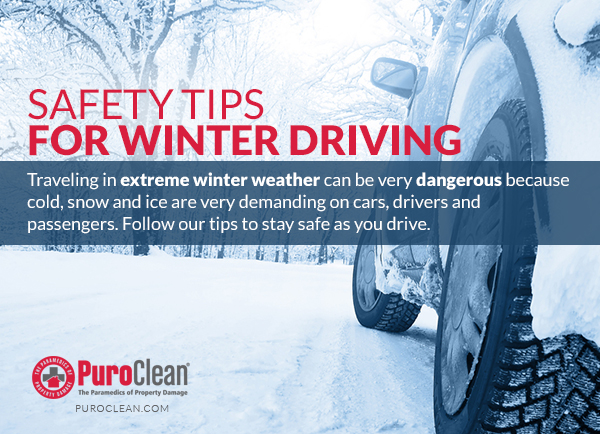 Traveling in extreme winter weather can be very dangerous because cold, snow and ice are very demanding on cars, drivers and passengers. Cold affects metal, rubber and other materials in your car. It can reduce the effectiveness of your vehicle’s battery by at least 50 percent. It can freeze tires and keep them flat on the bottom for at least the first half-mile of travel. It can thicken your car’s lubricants, making the engine work too hard. Most importantly, extreme winter weather can threaten your life. Follow these tips to stay safe as you drive:
Traveling in extreme winter weather can be very dangerous because cold, snow and ice are very demanding on cars, drivers and passengers. Cold affects metal, rubber and other materials in your car. It can reduce the effectiveness of your vehicle’s battery by at least 50 percent. It can freeze tires and keep them flat on the bottom for at least the first half-mile of travel. It can thicken your car’s lubricants, making the engine work too hard. Most importantly, extreme winter weather can threaten your life. Follow these tips to stay safe as you drive:
- Plan your trip carefully: listen to forecasts, road reports and storm warnings. Allow time in your schedule for bad weather and/or traffic delays.
- Prepare your vehicle for winter driving conditions. Get a tune-up and be sure to check the battery levels in your vehicle. Consider buying snow tires or chains for the tires, as your travel requires.
- To prevent fuel line freeze-up, keep your gas tank at least half full. Fill your gas tank before your vehicle is parked for lengthy periods.
- Be aware of your vehicle’s winter weather operating features. Front-wheel-drive vehicles generally handle better than rear-wheel vehicles on slippery roads because the weight of the engine is on the drive wheels, improving traction.
- Before you leave, clean frost and snow off all windows, mirrors, lights and reflectors. Equip your car with good wiper blades and keep an ample supply of windshield washer fluid. If visibility is poor, use headlights.
- Tell someone where you are going and the route you will take. Report your safe arrival. If you stall or get stuck, tie a colored banner (make sure you have one in your winter survival kit) to your antenna or hang it out a window. At night, remove the cover from your dome light and turn the light on. Road crews or rescue units can see a small glow at a considerable distance. To reduce battery drain, use emergency flashers only if you hear approaching vehicles. Keep one person on watch; don’t let everyone rest at the same time.
- When you first start your car, accelerate carefully to test wheel-spin and brake gently to test skidding. Use the accelerator and brakes slowly to maintain control of your vehicle. Fast acceleration can make wheels spin on ice and snow. Brake with a gentle pumping action. Stepping too hard on the pedal can lock the brakes and cause loss of steering control.
- If your vehicle is equipped with an Anti-lock Braking System (ABS), be sure to: STOMP – firmly depress the brake pedal. STAY on the brakes – do not pump the brakes. STEER where you want the vehicle to go.
- Gently pump non-ABS brakes to stop the vehicle. Take any corrective action gradually in order to maintain full control of the vehicle. Refer to the vehicle operations manual for proper methods to correct skids.
- Leave a braking distance between you and the driver in front of you up to nine times greater than usual when driving on snowy, icy surfaces than on dry roads.
- Drive with extreme caution on bridges and overpasses during freezing temperatures. Bridge temperatures can be 5-6 degrees colder than roadways; they can become slick and icy before roads.
- Dress appropriately; pack extra scarves and mittens instead of turning the heat too high. It’s much better to be cold and awake than comfortably warm and sleepy.
- Don’t run the engine unless you are sure the exhaust pipe is free of snow. Keep snow off the radiator to prevent the engine from overheating. Wet or wind-driven snow can plug your vehicle’s exhaust system and cause deadly carbon monoxide gas to enter your vehicle.
- In an emergency situation, you can intentionally steer your car off the road and into a snow bank. You may get stuck, but you’ll avoid a crash.
Check back with us to learn how to prepare an emergency kit for your car during winter time and don’t forget to like us on Facebook to get our notifications!



 PuroClean of Orland Park
PuroClean of Orland Park